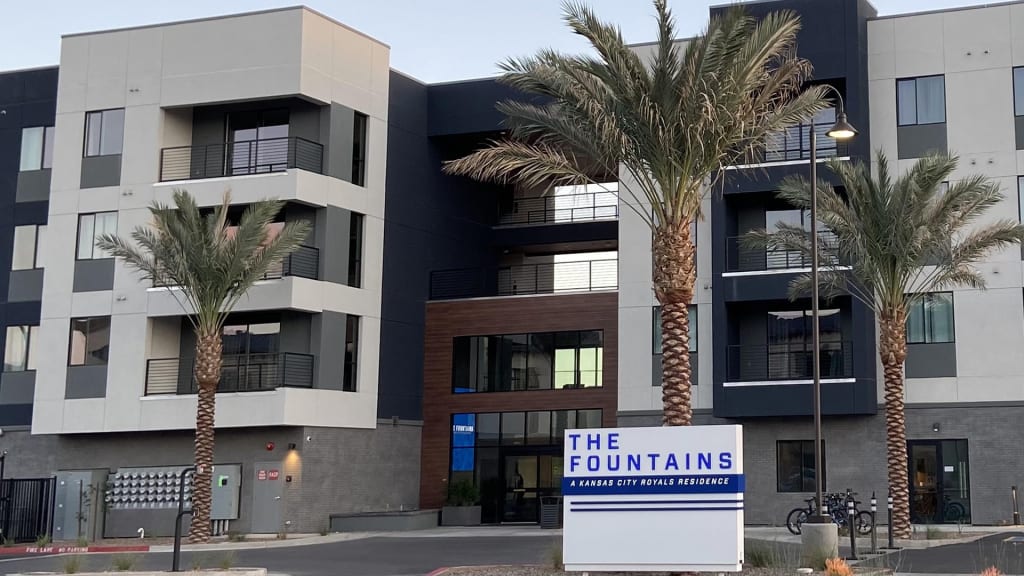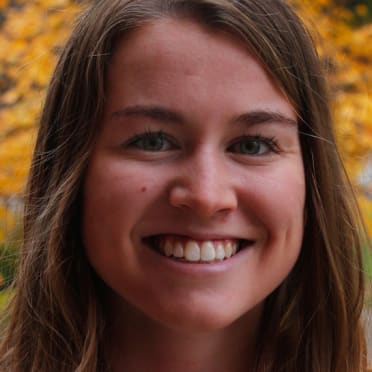
SURPRISE, Ariz. -- Sunny and in the mid-80s on Thursday afternoon in Surprise, Ariz., a swarm of Minor League players finished their work at the Royals' Spring Training complex and headed a half-mile down the road to a brand-new building.
As they entered, several stopped to chat with Arizona operations manager Nick Leto or check in with life skills coach Jorge Guzman before taking the elevator up to their rooms, heading out to the pool or entering the lounge area.
This building is called The Fountains, and it’s the Royals’ new housing facility for player development. It opened Nov. 19 and is now at full capacity with Minor League Spring Training in full go, and it has received rave reviews.
“It’s so nice,” said catcher Kale Emshoff, an undrafted free agent in 2020. “It’s way better than the hotel I was in last year. I can’t even explain how cool it is to live here.”
“It’s unheard of,” said infielder Michael Massey, who was drafted out of the University of Illinois in 2019. “I text my buddies who play for other organizations and they’re like, ‘Are you kidding me?’ But it’s all I know.”
“When we get back there, we’ll just talk about something that’s said that day or something that we learned,” said left-hander Frank Mozzicato, the Royals’ first-round Draft pick in 2021. “You learn a lot. I don’t know if we would have that outside of The Fountains.”
Named after Kansas City’s “City of Fountains” nickname, The Fountains is a four-story residence that includes a total of 47 units. Five of those units are reserved for staff. The rest is for players at no cost to them. At full capacity, it can sleep up to 176 people. It’s mandatory for players to live there unless they are married -- no overnight guests are permitted -- are in Major League camp when it opens or have time in Double-A or above.
“In some ways, you’ll never really know the impact,” said assistant general manager Scott Sharp, who was integral to the project. “But it speeds up and enhances development, gives players an option to work out in the offseason. At a hotel, you don’t really have a shared space, either. Here, you hope that they’re using the common space, hanging out, playing games. I definitely think there’s going to be an increase in bond.”
Amenities include a lounge filled with arcade games -- there’s a digital dartboard, a pop-a-shot basketball game, a ping-pong table, two pool tables, a shuffleboard and a table arcade that has games like Pac-Man -- a nutrition and kitchen area, a classroom, a staff lounge, a covered patio, a pool and a barber shop.
Players' rooms are fully furnished and can sleep up to four, and they include a kitchen, in-unit laundry machines and a balcony.
“Never in a million years,” one Royals staffer said when asked if he could imagine this setup when he was playing. “It is incredible.”
The story of The Fountains starts with legendary scout Art Stewart, who joined the Royals for their inaugural season in 1969, and was there for the opening of the Royals Academy, an innovation spearheaded by Ewing Kauffman. Constructed in Sarasota, Fla., for about $1.5 million, the facility housed young players, who took educational classes in the mornings before getting their baseball work done in the afternoons. All expenses were paid for by the Royals.
Stewart, who died in November, would bring in old pamphlets about the Academy and tell stories to Royals staffers.
“Art told us that when Mr. Kauffman opened the Academy, the Commissioner was there, all these dignitaries were there,” Leto said. “That’s how big of a deal it was. That just drove home the point. These people really believed in it. So we’re trying to match that enthusiasm a little bit.”
The Academy was costly and ended up closing in May 1974. But it spurred the careers of Frank White, a Royals Hall of Famer, and Ron Washington, among others.
“Another story Art told that was a big-time inspiration was that Mr. Kauffman told him that one of the biggest mistakes he ever made was closing the Academy,” Leto said. “It was expensive, but a lot of the fruit that came from it was after it closed.
“Art said that, and I’m like, ‘Jeez-o-pete, we got to build this thing.’”
Building was not an easy endeavor. The vision began 15 years ago, around the time president of baseball operations Dayton Moore came to Kansas City.
“How can we, in some ways, bring back the Royals Academy model?” Sharp said. “Have [the Surprise, Ariz., complex] as a year-round training facility. The concept was putting players in the best spot possible to maximize their development.”
The vision was there. The creation was complicated. Several hurdles halted progress, from the cost, to where to buy land, who would own it and who would operate the building. The Royals have worked with Patrick Boyd, a former Minor Leaguer who now owns Pro Housing Management, for several years on player housing, and in the late 2000s, he outlined what it would take for the club's housing facility to work.
“There were a couple of times where I felt like we were really close, and it just wasn’t the right time,” Sharp said. “I didn’t think it was happening until everyone ultimately signed off on it. There are some tricky parts.”
As the years went by, the ideas and plans changed as both the Royals and Boyd gained more experience in their areas and learned what they truly wanted. Other teams began building their own housing facilities, too. The Rangers, who share Surprise Stadium with the Royals, have their own building across the street from The Fountains. Cleveland worked with Boyd and opened its facility in 2019, in Goodyear, Ariz. The Royals toured that building shortly after it opened. Competition helped.
“I believe that helped to push this thing over the finish line,” Leto said.
Finally, the Royals and Boyd settled on their vision: Pro Housing Management would own and operate the building, as opposed to the team, which eliminates some future real-estate risk. The organization is the sole tenant on a lease, and Pro Housing Management does the managing, including maintenance and staffing.
Pro Housing Management officially broke ground in July 2020. From there, ideas about what would go inside were finalized. The Royals decorated the shared space with a Kansas City-centric theme. Pictures of Royals legends fill the lobby and lounge area, as well as the team's logos, the city’s KC logo and the logo of the Kansas City Monarchs of the Negro National League.
There’s even an enlarged image of the letter from a fan, dated March 10, 1968, that led to the Royals getting their team name.
“We tried to pay homage to the history of Kansas City and baseball, but do it in an interesting, artistic sort of way,” Sharp said.
Hurdles still remain. With Minor League Spring Training in full go, there are curfews and rules players must follow. The reaction, though, has been overwhelmingly positive from players, staff and officials. There is real impact -- from players arriving earlier in the year to use the Royals' complex for training to building relationships with teammates and coaches off the field. Massey even mentioned he and others are sleeping better as opposed to a hotel.
“Maybe a few years down the line, we can say that it made a big impact on certain players, that it kept them in the game,” Leto said. “That’s the dream, right? That’s why we do it.”


